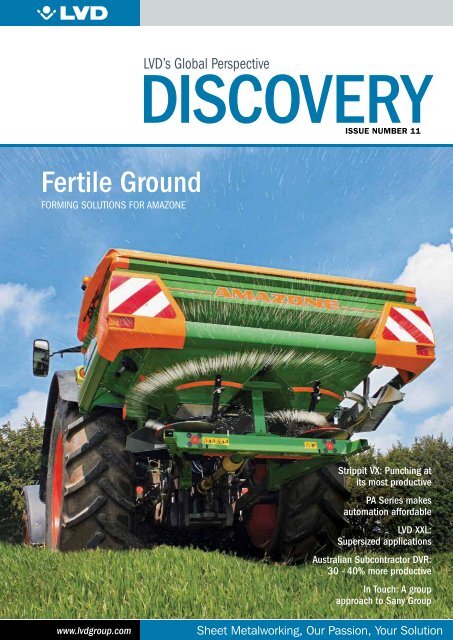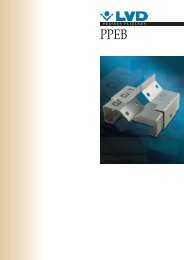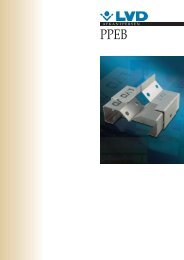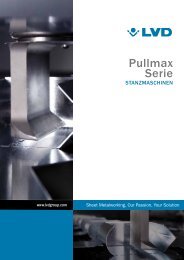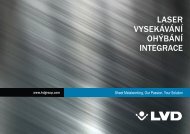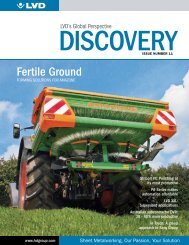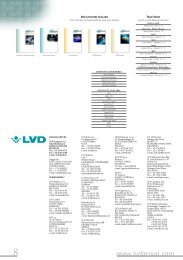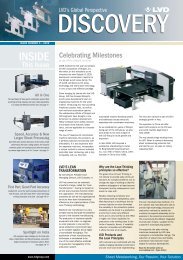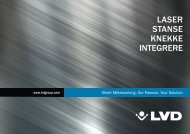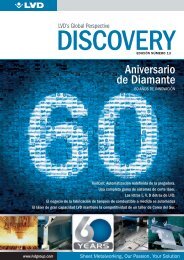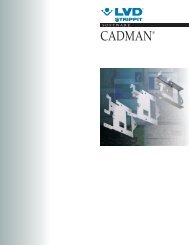Discovery Newsletter 11 - English International - LVD
Discovery Newsletter 11 - English International - LVD
Discovery Newsletter 11 - English International - LVD
Create successful ePaper yourself
Turn your PDF publications into a flip-book with our unique Google optimized e-Paper software.
<strong>LVD</strong>’s Global Perspective<br />
DISCOVERY<br />
ISSUE Number <strong>11</strong><br />
Fertile Ground<br />
Forming Solutions for Amazone<br />
Strippit VX: Punching at<br />
its most productive<br />
PA Series makes<br />
automation affordable<br />
<strong>LVD</strong> XXL:<br />
Supersized applications<br />
Australian Subcontractor DVR:<br />
30 - 40% more productive<br />
In Touch: A group<br />
approach to Sany Group<br />
www.lvdgroup.com<br />
Sheet Metalworking, Our Passion, Your Solution
INSIDE<br />
This Issue<br />
3 Editor’s Letter<br />
4 Strippit VX: Maximum punching performance<br />
6 PA-Series: Automation within reach<br />
8 Amazone discovers easy forming<br />
12 Supersized <strong>LVD</strong> XXL Applications<br />
page 12<br />
18 Recent Installations, new Tech Centers<br />
20 DVR: Australian job shop<br />
is flexible, and lean<br />
page 4<br />
22 <strong>LVD</strong> In Touch<br />
23 Latest News<br />
page 8<br />
page 18<br />
Editorial Notes:<br />
In honor of its tenth anniversary, we’ve updated<br />
and revamped <strong>Discovery</strong>.<br />
We’ve changed to a more reader-friendly format<br />
with more in-depth features and user profiles,<br />
and a cleaner, modern design that’s more inviting.<br />
While the content remains focused on products<br />
and solutions for more efficient, more productive<br />
sheet metal fabrication, you’ll find we’re delivering<br />
this information in a fresh new way.<br />
Share your comments and suggestions,<br />
marketing@lvd.be<br />
page 6<br />
<strong>LVD</strong> Company nv<br />
Nijverheidslaan 2, B-8560<br />
GULLEGEM, BELGIUM<br />
Tel. + 32 56 43 05 <strong>11</strong><br />
Fax + 32 56 43 25 00<br />
page 20<br />
Strippit, Inc.<br />
12975 Clarence Center Road<br />
Akron, NY<br />
Phone: 716-542-45<strong>11</strong><br />
Toll-free: 800-828-1527<br />
Fax: 716-542-5957
“Getting this balance<br />
wrong can mean increased<br />
part cost and ultimately<br />
decreased profit. ”<br />
From the<br />
EDITOR<br />
Mind Your P’s<br />
As the global recession begins to lift, you may be in a better<br />
position to expand your fabrication capacity. If so, now’s the<br />
time to take a hard look at your production requirements<br />
and at equipment that will help balance the three P’s: price,<br />
performance, profit.<br />
Finding the right price-to-performance ratio (that’s the price<br />
of the machine compared to its functionality) is something<br />
we’ve emphasized before, but it bears repeating as it’s more<br />
relevant than ever. Getting this balance wrong can mean<br />
increased part cost and ultimately decreased profit.<br />
We think the three P’s are so important, they are a key<br />
consideration with every product we build.<br />
Our newest punch press, the Strippit VX, is a perfect<br />
example. It’s the most productive punch press Strippit has<br />
ever engineered. A high production system, it’s ripe with<br />
robust features including a high-speed ram, innovative,<br />
high-capacity table, and new energy reduction system (ERS)<br />
that makes it one of the most energy efficient punch presses<br />
available today. It’s an ideal fit for shops that need high<br />
capacity for high throughput.<br />
The 3 P’s approach extends to automation where the<br />
question faced by shop owners when work levels increase<br />
is: Should they automate or should they hire Enter our<br />
new PA-Series autoload system, an affordable, flexible level<br />
of automation that can increase productivity without labor<br />
burden.<br />
How you balance the 3 P’s is unique to your requirements<br />
and objectives. Whatever your needs, we’ll help you mind<br />
your P’s and get the balance right.<br />
Matthew Fowles<br />
Group Marketing Manager<br />
<strong>LVD</strong> <strong>Discovery</strong> | 3
New Product<br />
FOCUS<br />
Strippit VX-Series<br />
Maximum Punching Productivity<br />
The new VX-Series delivers the highest level of punching productivity of any Strippit<br />
CNC turret punch press. A high-speed 20kN hydraulic ram combined with a large,<br />
versatile 48-station turret and innovative table design makes this turret punch press<br />
30% more productive than previous generation Global machines.<br />
Designed for High Performance<br />
An energy-saving hydraulic press drive and motor system optimized for high-speed<br />
operation generate fast axis speeds of up to 530 hits per minute on 25 mm centers<br />
and up to 1750 strokes per minute. An innovative table design has the capacity to<br />
handle sheet weights of up to 150 kg.<br />
The Strippit VX-Series is equipped with three programmable, relocatable work clamps,<br />
which can be programmed to a position on the X carriage and individually relocated to<br />
a new position within the part program. This reduces or eliminates “no punch” zones,<br />
increasing material utilization, providing significant savings when punching stainless<br />
steel and aluminum.<br />
A full 25 mm feed clearance between the upper and lower turret allows high quality<br />
forming for a wider range of applications, including the production of forms such as<br />
lances, louvers, embossments or card-guides.<br />
<strong>LVD</strong> <strong>Discovery</strong> | 4
Flexible Turret Configuration<br />
A double-track turret provides a<br />
flexible configuration of 48 stations<br />
featuring four standard 88,9 mm<br />
auto indexable stations that<br />
can utilize the latest wheel tool<br />
technology. Every station accepts<br />
shaped punches and dies and can<br />
be further enhanced with the addition<br />
of indexable multitools to expand the<br />
auto-indexable tools.<br />
Fast Set-up and Programming<br />
A state-of-the-art, PC-based Fanuc control makes machine set-up fast<br />
and simple. The control provides powerful features such as diagnostics,<br />
offers large program storage capacity and networking capability with user<br />
friendly MMI (man-machine interface).<br />
Optional CADMAN® programming software provides automatic unfolding<br />
of 3D SAT and IGES files, auto-nesting full support for all standard and<br />
advanced punching functions, including Auto-Index stations, Multi-Tools,<br />
standard and special punches, forming, embossing, tapping, stamping<br />
and wheel-style tools.<br />
Energy Efficient<br />
An energy reduction system (ERS) reduces machine<br />
energy consumption by 15%, making the Strippit<br />
VX-Series one of the world’s lowest energy consuming<br />
punch presses.<br />
Automation<br />
Options<br />
Strippit VX punch presses are automation<br />
compatible for integration with a load/unload<br />
system, Pick-Sort robotic material handling<br />
unit, or 4, 6 or 10-pallet Compact Tower for<br />
full material storage and retrieval.<br />
Automatic load/<br />
unload system<br />
Reduces worksheet handling time by as much<br />
as 80% and provides fast, efficient processing<br />
of materials up to 3,5 mm.<br />
Pick-Sort material<br />
handling system<br />
Converts the Strippit VX into a freestanding,<br />
lights-out production cell. This robotic system<br />
loads full size sheets and automatically<br />
retrieves and stacks individual punched parts<br />
with dimensions up to 1524 x 3048 mm. An<br />
offload system removes and stacks skeletal<br />
frames or nested sheets.<br />
Compact Tower (CT)<br />
Provides full capabilities for loading, unloading,<br />
and storage of raw material and finished<br />
parts, thus enabling automated production<br />
from stored raw material to stacked finished<br />
parts, as well as providing increased storage<br />
capacity.<br />
<strong>LVD</strong> <strong>Discovery</strong> | 5
New Product<br />
FOCUS<br />
Strippit PA-Series<br />
Compact, Cost-effective<br />
Automation<br />
Add a Strippit PA-Series automatic load/unload system to an existing Strippit punch<br />
press and transform your machine into a streamlined production cell.<br />
The Strippit PA-Series is compact, easy to use, easy to access and retrofitable for<br />
Strippit V, VX, and S-Series punch presses. It provides continuous, uninterrupted<br />
processing, delivering more value and productivity for your punching applications.<br />
An affordable automation system, the Strippit PA-Series is a budget friendly means of<br />
reaping the benefits of automated production, including better use of existing labor,<br />
reduced material handling, greater efficiency and productivity.<br />
Offered in two configurations: Strippit PA-1225 supports sheet sizes up to<br />
2500 x 1250 mm; Strippit PA-1530 handles materials up to 3048 x 1524 mm.<br />
Both systems work with minimum sheet sizes of 500 x 1000 mm in maximum<br />
sheet thicknesses of 3,5 mm.<br />
<strong>LVD</strong> <strong>Discovery</strong> | 6
Why Automate<br />
Continuous, uninterrupted<br />
production<br />
Key Features<br />
• Compact – single side system has a small footprint<br />
• Affordable – mid-level automation positioned for a limited budget<br />
• Robust – withstands rugged application<br />
• Easy to use – simple to program and operate<br />
• Reliable – engineered and designed for long production life<br />
A material handling system combined with a highspeed<br />
punching machine allows a continuous, even<br />
flow of work through the punch press, providing<br />
a high level of productivity. Worksheet handling<br />
time can be reduced as much as 80 percent.<br />
Use of larger blank<br />
sizes/workpieces<br />
Automated load/unload devices can handle large<br />
workpieces that can’t easily be managed in a<br />
manual operation, or where a two operator setup<br />
is needed. Automating the loading and unloading<br />
of the sheet takes advantage of the machine’s<br />
capacity to handle larger blanks, thus increasing<br />
efficiency.<br />
“Lights out” manufacturing<br />
Automating punch press operations makes “lights<br />
out” production feasible. Production can be<br />
switched to different nestings by automatically<br />
changing the program after one batch is finished.<br />
Double sheet detection and sheet separation<br />
devices prevent loading of multiple sheets.<br />
What users are saying:<br />
“We’re more productive than ever. Part<br />
processing is fast and uninterrupted;<br />
the machine and tower provide full<br />
loading, unloading and storage.”<br />
Chad Perfetti, fabrication manager<br />
G.A. Braun, USA<br />
“We have the flexibility to process<br />
a high volume of parts. The system<br />
provides a safe, efficient way of<br />
loading and unloading material.”<br />
Siow Siok Hwa, co-owner<br />
Golden Seal Pte. Ltd., Singapore<br />
<strong>LVD</strong> <strong>Discovery</strong> | 7
Application<br />
SPOTLIGHT<br />
Amazone is fertile ground for <strong>LVD</strong> bending technology<br />
“Right from the start we had<br />
the feeling that with <strong>LVD</strong> is<br />
wasn’t simply about buying<br />
a machine, it was about<br />
solving a problem. ”<br />
Dr. Stephan Evers<br />
<strong>LVD</strong> forming technology is helping to<br />
reduce rejects, improve quality and speed<br />
time to market with new products at a<br />
world leading manufacturer of agricultural<br />
equipment. A total of five <strong>LVD</strong> Easy-Form<br />
CNC press brakes – along with CADMAN-B<br />
offline programming software and stone<br />
radius tooling – have been installed at<br />
three of Amazone’s sites in Germany.<br />
At all three sites the key factor that<br />
convinced the works managers to invest<br />
in <strong>LVD</strong> was the recognition that it offered<br />
an integrated and logical approach to<br />
the whole bending process. It is not<br />
just about the machine itself, it also<br />
encompasses the Easy-Form angle<br />
measurement system to ensure accurate<br />
bend angles, <strong>LVD</strong> CADMAN-B 3D offline<br />
programming software to ensure accurate<br />
developments, the user-friendly CADMAN<br />
graphical control and Stone Radius<br />
tooling to ensure repeatability and a<br />
smooth forming process.<br />
Herr Günter Aljets, who heads up<br />
production at Amazone’s Hude works,<br />
where the first <strong>LVD</strong> press brake was<br />
installed, first came across <strong>LVD</strong> at a<br />
Euroblech exhibition and he realised<br />
that it could provide the solution he was<br />
looking for.<br />
“What was clear from our discussions<br />
that <strong>LVD</strong>’s approach was not just to<br />
sell a machine, it had really analysed<br />
the bending process and set about<br />
optimising it.”<br />
Dr Stephan Evers, previously head of<br />
production at Gaste and now works<br />
director of the Hude plant agrees: “We<br />
looked at all the main suppliers and all<br />
the machines were pretty similar, but I<br />
had the feeling that they weren’t really<br />
addressing the main question. They were<br />
happy to try and sell their machines, but<br />
they hadn’t really got to grips with the<br />
main problems. And the typical problems<br />
in fabrication are the accuracy of the<br />
bend angle and the length of the<br />
formed flange.<br />
“Right from the start we had the feeling<br />
that with <strong>LVD</strong> is wasn’t simply about<br />
buying a machine, it was about solving a<br />
problem. That was what impressed me.<br />
They had looked at all the problems that<br />
we had grappled with in house and come<br />
up with an integrated bending philosophy<br />
to address them. So we made the<br />
decision to go with <strong>LVD</strong> too.”<br />
Solving Robot<br />
Welding Problems<br />
The most recent machine was installed at<br />
Amazone’s BBG subsidiary in Leipzig. The<br />
500T PPEB 500/40 press brake is used<br />
to produce a wide variety of formed parts<br />
in material from 3mm up to 30mm thick,<br />
including high strength steels, that are<br />
later robot welded into sub-assemblies<br />
for various types of cultivator.<br />
<strong>LVD</strong> <strong>Discovery</strong> | 8
Amazone manufactures fertiliser<br />
spreaders, seed drills, powered (rotary<br />
cultivators and rotary harrows) and nonpowered<br />
soil cultivation (disc cultivators<br />
and harrows), precision air planters and<br />
crop protection sprayers for medium-sized<br />
farms, large estates and contractors.<br />
<strong>LVD</strong> <strong>Discovery</strong> | 9
Before the installation of the <strong>LVD</strong> press<br />
brake, lack of control over the bend<br />
angle, particularly on thick plate meant<br />
that there were real problems with the<br />
robot welding.<br />
Parts didn’t fit in the welding jigs and<br />
inconsistent joint gaps meant a lot of<br />
remedial work was required. This took<br />
time and had a knock on effect on<br />
productivity. Since the <strong>LVD</strong> technology<br />
has been introduced these problems<br />
have been solved and a further three<br />
robot welding cells installed.<br />
As Herr Jorg Pollex, works manager at<br />
BBG, explains: “The important thing for<br />
us is repeatable accuracy.”<br />
In terms of productivity he has found<br />
that setups are faster with minimal tool<br />
change times and significantly quicker<br />
programming, but the decisive factor is<br />
that after a changeover the machine very<br />
quickly starts producing accurate parts<br />
– and they stay accurate too, event when<br />
there are variations in material thickness<br />
and tensile strength.<br />
“The proof of that is that we hardly ever<br />
get any non-conformance reports on<br />
welded assemblies because of the bending<br />
process. With fewer rejects and faster<br />
setups our optimum batch size can<br />
be smaller. We have also been able to<br />
reduce stock because we can be more<br />
flexible in the way we load the machine.<br />
The process is altogether more secure<br />
and more stable.”<br />
Non-conformance<br />
Reports Slashed<br />
At Amazone’s plant in Gaste, two <strong>LVD</strong><br />
Easy-Form press brakes, a 400T PPEB-H<br />
400/50 and a 170T PPB-EFL 170/30,<br />
both of which were installed in 2007, have<br />
reduced non-conformance reports by 40%.<br />
As production manager Herr Stefan<br />
Holthaus explains: “A very big factor in<br />
the purchase of the <strong>LVD</strong> machines was<br />
the accuracy. We weld a great many parts<br />
by robot and the number is constantly<br />
increasing. Before we bought the <strong>LVD</strong><br />
machine we had problems with accuracy<br />
of the bend parts in robot welding – weld<br />
gaps were too big, we didn’t achieve the<br />
right bend angle, parts didn’t go together<br />
properly. <strong>LVD</strong>’s angle measurement<br />
system it was a crucial factor in our<br />
decision to buy the machines.”<br />
Herr Holthaus says that the <strong>LVD</strong><br />
system has also helped to speed up<br />
the introduction of new products. “In<br />
the past designs came down from the<br />
development office and it was up to<br />
production to make them. If they weren’t<br />
suitable for mass production it meant<br />
a lot of problems, a lot of rejects and<br />
a lot of going backwards and forwards<br />
between the design and production<br />
departments to improve the part.”<br />
Now the parts are designed in the<br />
CADMAN-B software and the integrated<br />
database makes all the correct bend<br />
angle assumptions to produce an<br />
accurate development. This ensures that<br />
the formed flanges on the component are<br />
the right length and correctly aligned with<br />
the other features.<br />
Parts are then trialled on the machine<br />
and the production department gives<br />
feedback on how modifications that<br />
would make them easier to produce<br />
– ensuring holes aren’t too near the<br />
bend line for example, or changing a<br />
flange length to make it easier to bend.<br />
By cutting out time intensive trial and<br />
error the development department has<br />
saved the equivalent of half a full time<br />
employee’s time.<br />
The CADMAN-B database is supplied with<br />
thousands of generic bend allowances<br />
for particular combinations of tools and<br />
materials, but <strong>LVD</strong> always recommends<br />
that customers add actual data from<br />
their own production. The team at BBG<br />
has been meticulous in adding bend data<br />
to its CADMAN-B database – carrying<br />
out test bends for every combination of<br />
material, thickness and tool set. This<br />
has paid off says Herr Pollex. “I’m glad<br />
<strong>LVD</strong> insisted that it was important to<br />
maintain our database. It now contains<br />
comprehensive information on all our<br />
tools and materials so the developments<br />
always come out right”<br />
Mr Holthaus adds that with the<br />
introduction of CADMAN-B software the<br />
design department has become much<br />
more aware of what is feasible. That<br />
has made them more ambitious and the<br />
parts they are creating have become<br />
more complex – and they could only<br />
be produced using offline programming<br />
rather than programming at the machine.<br />
He says that the operator interface on<br />
the machine has also improved quality –<br />
<strong>LVD</strong> <strong>Discovery</strong> | 10
the graphical display of the bend sequence<br />
make it much easier for the operator to<br />
interpret what needs to be done and<br />
avoid errors.<br />
“We can do things now where before<br />
we had problems in the workplace<br />
interpreting the drawings – particularly<br />
where there were nested or compound<br />
bends. Now we can see very clearly from<br />
the software how it all goes together. The<br />
offline programming is a massive advance<br />
for us. Importing programs has given us a<br />
big step forwards in terms of productivity.”<br />
Visualizing the Bend<br />
Sequence<br />
The first of Amazone Group’s <strong>LVD</strong><br />
Easy-Form press brakes – a 220T<br />
PPEB-EFL 220/30 – was installed at<br />
its Hude plant in November 2006 and<br />
joined by a second machine a year later.<br />
Together they produce formed parts for<br />
seed drills and cultivators. Herr Lund,<br />
one of the production engineers at<br />
Hude, agrees that the graphic display<br />
on the machine control is a real benefit.<br />
“Being able to visualise the bend<br />
sequence makes the machine very easy<br />
to use, even for untrained people. They<br />
can learn how to use it very quickly and<br />
make fewer mistakes.”<br />
“The freedom that laser cutting gives<br />
in the production of blanks has made<br />
designers a lot bolder. For example,<br />
they are creating much more complex<br />
assemblies that reduce the amount of<br />
welding required. But it does make the<br />
bend sequence more complicated, so<br />
visualisation is very helpful. And of course<br />
the greater bend accuracy ensures that<br />
the components come together properly.”<br />
Final Component<br />
The final component in the <strong>LVD</strong> solution<br />
is its Stone Radius tooling. This has a<br />
special compound radius profile that<br />
allows the plate to flow smoothly into<br />
the die during forming.<br />
“Stone radius tooling isn’t just a<br />
marketing gimmick,” says Herr Pollex.<br />
“Without it we used to get chatter marks<br />
on then plate. These had to be polished<br />
out or else they would give a poor painted<br />
finish. And when we did springback tests<br />
the chatter meant that we didn’t get an<br />
accurate reading.<br />
The stone radius tooling gives much better<br />
repeatability agrees Herr Lund, and with<br />
a lot less tool wear. He says the tooling<br />
on the first machine at Hude has been<br />
running for over four years now with no<br />
sign of wear.<br />
The Right Decision<br />
All three works managers are convinced<br />
that the decision to invest in <strong>LVD</strong><br />
technology was the right one. “I would<br />
unreservedly recommend the machines,”<br />
says Herr Pollex. “<strong>LVD</strong> use the phrase<br />
‘first part, right part’ and they proved that<br />
was the case.”<br />
Doctor Evers adds: “It was never<br />
stipulated from above that we had to go<br />
with <strong>LVD</strong>, all three of us independently<br />
came to the same conclusion that they<br />
were the right machines for us.”<br />
And as Herr Aljets concludes: “We<br />
were convinced by the technology. We<br />
put our money on <strong>LVD</strong> against a lot of<br />
competition, and I’m pleased to say we<br />
put it on the right horse.”<br />
“Being able to visualise the<br />
bend sequence makes the<br />
machine very easy to use,<br />
even for untrained people. ”<br />
Herr Lund<br />
<strong>LVD</strong> <strong>Discovery</strong> | <strong>11</strong>
In addition to satisfying the needs<br />
of standard bending operations, <strong>LVD</strong><br />
has also built a reputation for custom<br />
press brake manufacturing, designing<br />
and building press brakes as large as<br />
3000 tons in stand-alone and tandem<br />
configurations. These extra large, extra<br />
performance machines address the<br />
unique needs of heavy plate forming.<br />
To get the big picture perspective,<br />
<strong>Discovery</strong>’s editorial crew travelled<br />
to Germany to visit with eight custom<br />
press brake users.<br />
XL<br />
Supersized<br />
Forming<br />
When the forming<br />
requirements are big,<br />
so is the solution.<br />
<strong>LVD</strong> <strong>Discovery</strong> | 12
Accurate Forming of<br />
Crane Booms<br />
The KSK plant at Schwerte, part of the Vlassenroot<br />
group, has expanded its capacity for the production<br />
of mobile crane booms with the installation of a<br />
new <strong>LVD</strong> PPEB-H 2000T 14m press brake.<br />
Vlassenroot is one of the world’s major<br />
manufacturers of critical components for<br />
mobile cranes and operates across four sites<br />
in Belgium, Germany and Poland. One of the<br />
strengths of the group is that it has all of its<br />
production processes in-house and can offer<br />
crane manufacturers a complete fully welded<br />
boom and chassis from one supplier.<br />
In fact, the acquisition of KSK in 1999, which<br />
had extensive welding facilities, was driven<br />
by the demand from crane manufacturers for<br />
complete welded booms.<br />
“We have complete control of the whole<br />
process, from steel to welded boom section,<br />
and we are the only one in the world that can<br />
offer that,” says Ludwig Deckers, plant manager<br />
at Schwerte. “That gives us a lot of advantages<br />
and it gives the crane manufacturers a lot of<br />
advantages too.”<br />
He adds that in recent years the strongest part<br />
of the market has been in cranes for the wind<br />
power sector, which puts Vlassenroot at an<br />
advantage because its <strong>LVD</strong> press brakes give<br />
it the large-scale production capability to meet<br />
this demand.<br />
“The largest crane we build parts for has a 500T<br />
capacity and the longest section we produce at<br />
Schwerte is 14,55m long. We supply all leading<br />
crane companies throughout the world.<br />
Herr Deckers explains that the partnership with<br />
<strong>LVD</strong> goes back a number of years.<br />
“Our first link with <strong>LVD</strong> came when we asked<br />
them to rebuild one of these as a CNC machine<br />
with new hydraulics and controls. It all went<br />
exceptionally smoothly so we asked them to<br />
rebuild all our press brakes. So when<br />
we needed new capacity in Belgium it was<br />
a natural step for us to go to them for new<br />
machines too. We now have two 2000T <strong>LVD</strong><br />
PPEB 14m press brakes at our Belgian plant.<br />
“We went to <strong>LVD</strong> for this new machine too<br />
because of the good experience we’d had with<br />
them and the service they provide.”<br />
The new machines <strong>LVD</strong> built for Vlassenroot<br />
– and now KSK – were designed specifically to<br />
be the optimum configuration for crane boom<br />
forming in high strength steels.<br />
The latest machine includes a couple of further<br />
refinements. The first is a series of CNC pushers<br />
at the front of the machine that ensure the plate<br />
is firmly located on the back gauges.<br />
“It was a hell of a job for the operators to push<br />
these long and heavy components up against the<br />
back gauges, so we asked <strong>LVD</strong> to come up with<br />
an automatic system rather than using manpower.<br />
It has worked very well,” says Herr Deckers.<br />
The second special feature is a bottom die that<br />
can be adjusted in 10mm increments from<br />
<strong>11</strong>0mm up to 320mm. This is to allow KSK to<br />
cope with some of the very large bend<br />
radii required on the higher strength steels.<br />
Bending these materials requires special<br />
expertise and the highest quality equipment<br />
says Mr. Deckers.<br />
“In normal steel, to bend an angle of 90 degrees<br />
you may have to bend to 89 or 88 degrees to<br />
allow for springback. With the <strong>11</strong>00 Newton<br />
tensile strength material we commonly bend you<br />
may have a springback of 30 degrees – so you<br />
have to bend to 60 degrees. So you need a lot<br />
of force to go into the die to bend the material.”<br />
The stronger the material, the lighter and taller<br />
the crane builders can make their telescopic<br />
booms. There is currently talk of 1300 Newton<br />
or even 1600 Newton tensile strength steel in<br />
the future – but that would require designs and<br />
welding materials that have yet to be developed.<br />
“The bend accuracy is crucially important to us<br />
because of the requirements of the end product.<br />
Although we are making very large components<br />
– up to more than 14m long – the tolerances<br />
the customers are asking for are very tight. On<br />
a boom section 1,6m in diameter, the height<br />
and the width have to be within plus or minus<br />
2mm on the welded fabrication. Otherwise, the<br />
telescopic boom sections won’t slide in and out<br />
properly,” says Herr Deckers.<br />
“After only a few weeks of operating the<br />
new machine it has proved itself to be more<br />
accurate and more productive than the machine<br />
we had before. I didn’t expect such positive<br />
results so quickly.”<br />
“The bend accuracy<br />
is crucially important<br />
to us because of the<br />
requirements of the<br />
end product.”<br />
Herr Deckers<br />
To read the full version of this article,<br />
visit www.lvdgroup.com.
“We wanted to be able to<br />
offer components that other<br />
people couldn’t offer. We<br />
like challenges and start at<br />
the point where others have<br />
reached their limits.”<br />
Herr Roterring<br />
<strong>LVD</strong> <strong>Discovery</strong> | 14<br />
Biggest Is Best for Wiropa<br />
When the directors of Wiropa set up the<br />
company in 2008, they had a clear picture<br />
of what they wanted to offer customers.<br />
This was a subcontract cutting, forming<br />
and processing service with a focus on<br />
heavy engineering sectors, but with the<br />
emphasis on being able to offer very large<br />
components (XXL – Extra – Extra – Large)<br />
to customers in sectors such as crane<br />
building, wind power and shipbuilding.<br />
It is reflected in the equipment and<br />
facilities at Wiropa’s facility at Gescher,<br />
Northern Germany.<br />
At the heart of Wiropa’s capacity is one of<br />
the largest tandem press brakes ever built<br />
by <strong>LVD</strong>. This comprises two identical 10,2m<br />
<strong>LVD</strong> PPEB – H press brakes, each with a<br />
press force of 1250 tonnes, which can<br />
either operate as individual machines or be<br />
combined to create a single 20,4m press<br />
brake with a press force of 2500 tonnes<br />
under a single control.<br />
The result is that Wiropa has the flexibility<br />
to form a very wide range of components,<br />
from small parts in 1,5mm stainless up to<br />
very long parts 30mm thick.<br />
Matthias Roterring, who set up Wiropa with<br />
Thorsten Paul and Ludger Witte, explains the<br />
company’s philosophy: “We wanted to be able<br />
to offer components that other people<br />
couldn’t offer. We like challenges and start<br />
at the point where others have reached<br />
their limits. By offering customers the lengths<br />
and widths of material that we can process<br />
they can have bigger and longer sections<br />
with fewer welded seams and joints. Our<br />
aim is to solve our customers’ problems.”<br />
Drawing on experience<br />
When the three directors set up the company<br />
they drew on a combined experience of<br />
over 50 years in the sector to determine<br />
the equipment they needed.<br />
Herr Roterring says: “When we came to buy<br />
the press brakes we looked for machines and<br />
manufacturers that could meet the technical<br />
specifications we knew we needed. We also<br />
looked at what experience the supplier had<br />
in this field and its position in the market.<br />
From a technical point of view, <strong>LVD</strong><br />
answered all Wiropa’s questions.<br />
Torsten Paul takes up the story: “Normally,<br />
people come to <strong>LVD</strong> with a product and ask<br />
how can they make it. In our case, we haven’t<br />
got a product of our own so we went to<br />
<strong>LVD</strong> with a very precise enquiry specifying<br />
press force, bed length, throat size, frame<br />
opening, tool holding – everything.<br />
So why did Wiropa choose a tandem<br />
machine, and why that size<br />
“First of all we decided that we wanted two<br />
press brakes because of the security and<br />
flexibility that would give us,” says Herr<br />
Paul. “We had established that a significant<br />
proportion of the parts we were likely to<br />
be forming would be in the region of 8m<br />
to 10m long, and because of the way we<br />
were set up with the profiling, cranes and<br />
hall layout we could see that there might
e a call for parts in the 14 to 16m long<br />
range too. So we thought, let’s not get one<br />
big machine, or one big machine and two<br />
small machines. Let’s get two identical<br />
10m machines that we can combine to<br />
give a 20m machine.”<br />
It was not enough to get the size of press<br />
they wanted; Wiropa also wanted to be at<br />
the forefront of bending technology and be<br />
ready for any future demands.<br />
Herr Roterring explains: “We wanted the<br />
latest machine with the latest technology<br />
built in, and we think that in this respect<br />
<strong>LVD</strong> is ahead of the field.<br />
The press brakes are fitted with <strong>LVD</strong>’s<br />
advanced Easy-Form ® angle measurement<br />
system, which ensures the correct bend<br />
angle is achieved even when there are<br />
variations in material thickness and strength.<br />
The tandem press also features <strong>LVD</strong>’s<br />
latest programmable crowning system for<br />
long piece parts – Bi-Comp which offers<br />
a unique and intelligent synchronisation<br />
of the two independent V-axis crowning<br />
systems. This ensures perfect bending over<br />
the full 20m even on the most challenging<br />
materials especially in specialised steels<br />
such as Hardox and Weldox typical for<br />
Wiropa.<br />
And as they say ‘The proof was in the<br />
eating’ when Wiropa formed some 2,4m<br />
long components in Hardox 500. The press<br />
force required was near the maximum possible<br />
on the press and yet a consistent bend<br />
accuracy of 0,2 degrees was achieved<br />
across the three required components. No<br />
reworking, no extra parts for set up, just<br />
three correct parts, right the first time.<br />
Positive relationship<br />
Wiropa’s positive relationship with <strong>LVD</strong> comes<br />
from a feeling that they are a good partner<br />
to do business, with says Herr Roterring.<br />
“When we first visited <strong>LVD</strong>’s factory, everything<br />
we saw there made a very good impression.<br />
The attention to detail, the fact that they<br />
made all the components themselves, such<br />
as the hydraulic cylinders; everything we saw<br />
made it clear that <strong>LVD</strong> knew what it was<br />
doing when it came to building machines.<br />
That gave me the confidence that <strong>LVD</strong><br />
could give us what we were looking for.<br />
“This carries through to the service and installation<br />
engineers too. Everything has gone<br />
very well. We would recommend <strong>LVD</strong> machines<br />
to other people, and we already have.”<br />
Summing up, Herr Witte says that the<br />
specification and technology of the <strong>LVD</strong><br />
equipment is paying dividends.<br />
“We haven’t been in business long but we<br />
have already seen that the diversity of what<br />
we can do is extremely important. We can<br />
make products that other people can’t, and<br />
we can make the parts they can make too.<br />
So the customer<br />
can get everything<br />
they need from<br />
one supplier –<br />
from 1mm to<br />
40mm thick.<br />
To read the full version of this article,<br />
visit www.lvdgroup.com.
“The spectrum of parts we<br />
can produce on the <strong>LVD</strong><br />
laser allows us to be very<br />
flexible – and produce parts<br />
in larger sizes to a higher<br />
quality than plasma or<br />
flame cutting. ”<br />
Herr Schumacher<br />
Large <strong>LVD</strong> Laser Brings<br />
Customer Closer<br />
Based in Ehingen, Southern Germany, the<br />
firm of Schumacher GmbH is close to its<br />
biggest customer Liebherr in every sense.<br />
Schumacher produces all kinds of sheet,<br />
plate and tube parts for Liebherr’s<br />
telescopic mobile cranes – amounting to<br />
around 30000 part numbers in structural<br />
steel, aluminium and stainless. These<br />
range from parts in 1,5mm sheet metal for<br />
enclosures, cladding and electrical cabinets<br />
up to much heavier components for<br />
applications such as stabilising outriggers,<br />
working platforms and chassis frames.<br />
Minimizing<br />
Non-productive Time<br />
With the <strong>LVD</strong> Impuls, Schumacher can<br />
profile parts up to 12,5m by 3100 mm in<br />
material up to 25mm thick fine-grained,<br />
high-strength steel, 16mm aluminium and<br />
20mm stainless steel. This means it can<br />
process the complete spectrum of parts for<br />
Liebherr – as well as other customers in the<br />
truck and machinery sectors – using the<br />
same machine.<br />
The machine has twin shuttle tables so that<br />
parts can be loaded and unloaded on one<br />
table while profiling continues on the other<br />
table – minimising non-productive time.<br />
As the head of the company Herr Gerhard<br />
Schumacher explains: “They count our<br />
machines as part of their production capacity.”<br />
Trend Toward Bigger<br />
Components<br />
In fact, with the purchase of a 6kW <strong>LVD</strong><br />
12530 Impuls laser with a 12,5 by 3,2m<br />
cutting capacity – reckoned to be the largest<br />
flying optic laser system on the market – it<br />
can produce large parts to laser quality that<br />
Liebherr could not do in-house.<br />
According to Herr Schumacher, the trend<br />
is towards bigger and bigger components:<br />
“The downturn in the construction industry<br />
has led to a reduction in demand for smaller<br />
mobile cranes, but the growth of the wind<br />
energy sector has boosted demand for the<br />
larger cranes required to erect and maintain<br />
wind turbines.”<br />
XXL<br />
Subsequently when Herr Schumacher<br />
searched the market for manufacturers of<br />
large laser bed laser cutting machines he<br />
found <strong>LVD</strong> was one of the few if not the only<br />
company able to offer him the experience and<br />
capabilities that he needed in such a machine.<br />
This feature also allows Schumacher to<br />
run the Impuls unmanned for long periods,<br />
including overnight.<br />
“We can lay up 8 large format plates, in<br />
different thicknesses and materials if we<br />
want, on each of the two shuttle tables. We<br />
can then run the machine without having<br />
to load or unload until it has processed<br />
all 16 plates – which means it can run<br />
automatically through the night shift,” says<br />
Herr Schumacher.<br />
Schumacher GmbH’s business was originally<br />
built on sheet metal craft skills, particularly<br />
for the construction sector, and parallel to<br />
its fabrication business it still installs and<br />
repairs roofs, building facades and steelframed<br />
buildings, as well as making one-off<br />
craftsman pieces. Indeed, this is how it first<br />
came to work with Liebherr when in the<br />
mid 1970s it won a contract to maintain its<br />
roofs and buildings.<br />
Somewhere along the way, in around 1982,<br />
Liebherr asked if Schumacher could supply<br />
components too. This was initially for sheet<br />
metal components such as tool boxes,<br />
covers, electrical cabinets and so on.<br />
“We slowly increased our machine capacity,<br />
and from producing what were essentially<br />
spares and maintenance parts we started<br />
making more and more production<br />
components,” says Herr Schumacher.<br />
Never Say No<br />
“We became Liebherr’s ‘fire brigade’. When<br />
they couldn’t do something in-house or<br />
needed something urgently we did it. Our<br />
policy was to never say no. If Liebherr<br />
couldn’t do it we would.<br />
<strong>LVD</strong> <strong>Discovery</strong> | 16
“Our machines are practically bound<br />
together with theirs. They think of our<br />
capacity here as part of their production<br />
capacity. We ship direct-to-line in Liebherr,<br />
we are linked into their ERP system and<br />
they send DXF files straight from their IT<br />
system to ours. Now, any of the sheet metal<br />
parts that you can imagine might go into a<br />
mobile crane could be produced here.”<br />
With the <strong>LVD</strong> Impuls 12530, Schumacher<br />
can laser cut parts that Liebherr can only<br />
make using oxy-gas or plasma cutting –<br />
which can’t achieve the cut quality and<br />
accuracy possible on a laser. On axle<br />
support components, for example, there is<br />
a requirement to create clean and accurate<br />
holes for large supporting bolts. Liebherr’s<br />
machines just don’t have the definition to<br />
do this, so, after plasma profiling, the holes<br />
had to be bored out on a milling machine.<br />
Using the <strong>LVD</strong> laser, the cut quality is so<br />
good that the bolts fit without the need for<br />
an additional machining stage – giving a<br />
more efficient and cost-effective process.<br />
“The spectrum of parts we can produce<br />
on the <strong>LVD</strong> laser allows us to be very<br />
flexible – and produce parts in larger sizes<br />
to a higher quality than plasma or flame<br />
cutting. This has brought us even closer<br />
to Liebherr and opened up opportunities<br />
in new products and markets,” concludes<br />
Herr Schumacher.<br />
To read the full version of this article,<br />
visit www.lvdgroup.com.<br />
“We can lay up 8 large<br />
format plates, in different<br />
thicknesses and materials if<br />
we want, on each of the two<br />
shuttle tables. We can then<br />
run the machine without<br />
having to load or unload<br />
until it has processed all<br />
16 plates – which means it<br />
can run automatically<br />
through the night shift.”<br />
Herr Schumacher<br />
<strong>LVD</strong> <strong>Discovery</strong> | 17
RECENT<br />
Installations<br />
<strong>LVD</strong> equipment is installed in manufacturing<br />
facilities across the globe,<br />
including some of the best-known<br />
manufacturing companies in the world.<br />
Galva Coat’s galvanized stadium lighting poles<br />
measure from 4m up to 20m.<br />
Ford Component Manufacturing Limited produces parts<br />
for the rail industry using <strong>LVD</strong> laser & punching equipment.<br />
Vanderlande Industries’ baggage handling system at<br />
Terminal 5 in London’s Heathrow Airport is one of the<br />
most complex, innovative projects of its kind.<br />
Malaysia<br />
LeBLANC Malaysia, Port Klang, a wholly<br />
owned subsidiary of LeBLANC <strong>International</strong><br />
PTE., has added a PPEB-H 640/61 press<br />
brake for the manufacture of broadcast<br />
towers, monopoles and other telecommunications<br />
equipment. The 640 ton custom<br />
press brake is used to produce LeBLANC’s<br />
unique three-legged telecommunication<br />
tower. The press brake was jointly manufactured<br />
by <strong>LVD</strong>-HD, the newly established<br />
joint venture company of <strong>LVD</strong> and Hubei<br />
Tri-Ring Metalforming Equipment Co., Ltd.<br />
Seik Lam Components Industries Sdn Bhd,<br />
Selangor, has installed a Sirius Plus 4 kW<br />
laser cutting system featuring a 10-unit<br />
Compact Tower system, as well as an<br />
Easy-Form Series 170/30 press brake with<br />
extra stroke and distance. A precision sheet<br />
metal fabrication facility, Seik Lam will use<br />
the equipment to produce a wide rage of<br />
precision products, including switchgear<br />
components, assemblies and sub-assemblies,<br />
indicator instrument parts and<br />
stationery items.<br />
Poland<br />
Feerum S.A., Chojnów, a leading manufacturer<br />
of silos, dryers, conveyors and other<br />
devices for grain processing has invested<br />
in two PPEB Series press brakes and an<br />
Axel 4020 4 kW laser cutting machine. The<br />
additional equipment increases capacity<br />
and complements Feerum’s existing <strong>LVD</strong><br />
punch presses and press brakes.<br />
Sweden<br />
Seabased Industry AB, Uppsala, part of the<br />
Seabased Group, has purchased an <strong>LVD</strong><br />
Axel S 3015 5 kW laser cutting system.<br />
Seabased AB develops industrial solutions<br />
for sustainable conversion of ocean wave<br />
energy to electricity. It is the world’s largest<br />
wave power plant producer. The company’s<br />
facility consists of 400 – 500 units with an<br />
installed power of approximately 10 MW.<br />
The Netherlands<br />
Vanderlande Industries, Veghel, has<br />
installed an Easy-Form® Series press<br />
brake to achieve high accuracy and quality<br />
bending of its automated material handling<br />
systems used in distribution centers, parcel<br />
and postal sortation facilities, as well as<br />
baggage handling at airports.<br />
United Arab Emirates<br />
Galva Coat Industries, Abu Dhabi, has<br />
installed an <strong>LVD</strong> Impuls 4020 R laser<br />
cutting system, Strippit V30-1525 punch<br />
press, PPEB-5 135/30 press brake and<br />
MVS 6/31 guillotine shear. The high<br />
performance equipment complements<br />
Galva Coat’s existing <strong>LVD</strong> 3000-ton custom<br />
tandem press brake and 14 m x 8 mm<br />
shear. Galva Coat is a leading manufacturer<br />
of galvanized lighting poles, transmission<br />
poles, guard rails, and structural steel<br />
fabrications.<br />
UK<br />
Ford Component Manufacturing Limited,<br />
Monkton, part of Ford Aerospace, recently<br />
installed an <strong>LVD</strong> Orion 2,5 kW laser cutting<br />
system for the processing of components<br />
for the automotive, power generation, rail,<br />
construction and other high-tech industries.<br />
The laser cutting system is the first laser<br />
for the facility which previously relied on<br />
punching equipment for its sheet metal<br />
fabrication operations.<br />
U.S.A.<br />
Ruskin Company, Kansas City, Missouri,<br />
has installed two Strippit V30-1525 turret<br />
punch presses at its Kentucky and West<br />
Virginia production facilities. Ruskin is a<br />
leading manufacturer of air and sound<br />
control products for the heating, ventilating<br />
and air conditioning (HVAC) market. The<br />
company is one of the largest air control<br />
solutions providers with 21 production and<br />
office locations worldwide.<br />
<strong>LVD</strong> <strong>Discovery</strong> | 18
Feerum S.A. builds products for<br />
all stages of grain processing:<br />
transporting the grain from the field,<br />
preliminary cleaning and drying,<br />
and precise cleaning, finishing at<br />
storage and safe keeping of grain.<br />
<strong>LVD</strong> <strong>Discovery</strong> | 19
Small<br />
Precision<br />
Fab Shop<br />
Embraces<br />
Automation<br />
with Big<br />
Results<br />
DVR is leaner, quicker to respond<br />
and 40% more efficient<br />
“By buying equipment with<br />
automation we have been<br />
able to reduce labor costs<br />
while still increasing<br />
production and reducing<br />
lead times.”<br />
Bob Viner, owner of DVR Metal Industries<br />
Bob Viner, owner of DVR Metal Industries,<br />
(www.dvrmetal.com.au), Queensland,<br />
Australia, has fuelled the growth of his<br />
12-person family run business with a<br />
simple philosophy: “If you don’t do anything<br />
different, nothing different will happen.”<br />
The philosophy has served Viner and his<br />
company well, as DVR has grown from<br />
its establishment in 1993 as a press<br />
shop with mostly hard tooling to a highly<br />
automated precision sheet metal supplier<br />
of garage doors, industrial buildings,<br />
appliances, and mining industry goods with<br />
annual sales exceeding $3.6 million.<br />
Along the way, Viner has recognized<br />
opportunities to do things differently,<br />
remaining flexible to quickly adapt to<br />
market needs and open to adopting new<br />
technology and processes.<br />
Case in point: While most companies DVR’s<br />
size might shy away from automation, Viner<br />
and his son, Production Director, Steve<br />
Viner, have embraced it. DVR purchased an<br />
<strong>LVD</strong> Strippit Global 20 1225 turret punch<br />
press with automated load/unload system<br />
in 2005. In 2007, the company added an<br />
<strong>LVD</strong> Axel 3015 L2 laser cutting system with<br />
integrated material handling.<br />
30 – 40% More Efficient<br />
Automation has made DVR 30 to 40<br />
percent more efficient, making it leaner and<br />
more responsive to customers’ changing<br />
and often challenging requirements.<br />
“By buying equipment with automation we<br />
have been able to reduce labor costs while<br />
still increasing production and reducing<br />
lead times,” said Viner. “The capability to<br />
run ‘lights out’ with automation has also<br />
seen production levels increase without the<br />
need for more shifts.”<br />
Viner’s goal is to function as an extension<br />
of his customers’ production shops. For<br />
a small, dedicated list of customers, DVR<br />
serves as a preferred supplier, providing<br />
complete design, manufacturing and<br />
assembly services.<br />
DVR handles a range of materials, including<br />
mild steel, galvanized steel, aluminum and<br />
stainless steel ranging in thicknesses from<br />
0,55 to 12 mm.<br />
Automating Instinctively<br />
The Viners stay abreast of new technology<br />
and trends by attending industry trade<br />
shows around the world. They began<br />
considering their first piece of automated<br />
equipment after visits to the Euroblech<br />
exhibition and the U.S.-based Fabtech show.<br />
“We saw automation at various trade shows<br />
and felt that it was the way we wanted to<br />
go,” explained Viner. “What we found with<br />
<strong>LVD</strong> was that it wasn’t a multi-million dollar<br />
investment for large companies only, it was<br />
quite affordable for a company of our size.”<br />
There was no long justification process for<br />
DVR’s first automated machine, the Strippit<br />
punch press with load/unload. The decision<br />
for the purchase was more of an instinct.<br />
“Being such a small and agile family<br />
business, we can decide quite quickly<br />
if a machine or piece of equipment can<br />
benefit, complement or replace existing<br />
equipment,” said Viner.<br />
DVR’s <strong>LVD</strong> Strippit 20-ton punch press<br />
is equipped with an automatic load/<br />
unload system able to handle sheets up<br />
to 2500 mm x 1250 mm for processing of<br />
large workpieces or multiparts in material<br />
thicknesses up to 3,5 mm. A compact,<br />
space-saving design loads and unloads<br />
material from the same side of the turret<br />
punch press.<br />
The automated punch press reduced DVR’s<br />
manual worksheet handling and proved an<br />
efficient method of processing workpieces.<br />
As the punch press processes parts,<br />
the machine operator is free to perform<br />
other functions. With only four machine<br />
operators, maximizing the use of workers’<br />
time is key to DVR’s profitability.<br />
Having benefitted from automating its<br />
punching operations, DVR looked to<br />
replace its stand-alone hybrid-style laser<br />
with an automated laser cutting system<br />
and turned again to <strong>LVD</strong>.<br />
DVR’s Axel 3015 is a high-speed flying<br />
optics laser featuring a fully integrated<br />
load/unload system that permits smooth,<br />
continuous part processing.<br />
The machine is configured with two loading<br />
stations. These extra stations improve the<br />
flexibility of the system without the need to<br />
invest in a storage tower.<br />
From Concept to<br />
Finished Part Faster<br />
To support the automated punching and<br />
cutting applications, DVR has two <strong>LVD</strong><br />
PPEB precision press brakes in 135 and<br />
80 metric ton capacities.<br />
DVR employs <strong>LVD</strong>’s CADMAN ®<br />
programming software – the complete<br />
punching, bending and laser cutting suite<br />
– to integrate its fabrication operations,<br />
another way the company “automates” its<br />
operations. A Windows-based software,<br />
CADMAN provides easy, sheet metal<br />
<strong>LVD</strong> <strong>Discovery</strong> | 20
oriented CAD functions for the design of<br />
formed and fabricated parts.<br />
“CADMAN software enables us to program<br />
jobs offline and seamlessly integrate jobs<br />
between all machines,” said Viner.<br />
“Now we can draw one part and that<br />
geometry can be used for the turret or the<br />
laser,” said Steve Viner. “We don’t have<br />
multiple programs. It’s all one package. One<br />
of the biggest gains that we have is that the<br />
customer sends us 3D files that they have<br />
drawn and we can unfold them and get an<br />
accurate part from the first go.”<br />
The CADMAN-B 3D module automatically<br />
determines the bend sequence, automatic<br />
gauging and tool selection, all optimized<br />
for minimum tool stations and part turns.<br />
The software module provides accurate and<br />
detailed profile drawings and automatically<br />
communicates directly with the press brake<br />
control.<br />
“In the past, if a customer wanted 100 parts,<br />
we would produce 105 because we knew<br />
that we would destroy five pieces during the<br />
setup,” explained Viner. “Now, we just cut 100<br />
parts because with the bending software, we<br />
get 100 good parts. From my perspective,<br />
that’s probably one of the best things with<br />
<strong>LVD</strong>, the automation of the process.”<br />
The DVR – <strong>LVD</strong> relationship is based on a longstanding<br />
partnership that began 15 years ago.<br />
“Our relationship is at the highest level,” said<br />
Viner. “But it’s the way the equipment has<br />
performed and the consultative approach<br />
<strong>LVD</strong> has provided that demonstrates their<br />
commitment to us.”<br />
<strong>LVD</strong>’s advanced equipment combined with the<br />
CADMAN software solution makes its easier for<br />
DVR to produce parts quickly and accurately.<br />
“Since adding automation, we haven’t looked<br />
back,” added Viner. “Customers know that<br />
their products are manufactured at the most<br />
efficient level.”<br />
Since this article was written,<br />
DVR has invested in more market<br />
leading technology from <strong>LVD</strong>,<br />
purchasing an Easy-Form 220 ton –<br />
3m CNC press brake equipped with<br />
CADMAN® Touch control,<br />
Easy-Form® Laser in process<br />
adaptive bending system, modular<br />
backgauge unit and extended<br />
open high and stroke.<br />
<strong>LVD</strong> <strong>Discovery</strong> | 21
<strong>LVD</strong> In<br />
TOUCH<br />
Custom Collaboration:<br />
Group effort makes Sany<br />
Group’s 3000 ton custom<br />
press brake a reality<br />
“We secured this contract<br />
because we approached this<br />
project as a team, with a<br />
sharing of ideas and goals<br />
and a shared responsibility.”<br />
Patrick Deferme,<br />
<strong>LVD</strong> Marketing and Sales Director<br />
When Sany Group Co. Ltd., Changsha,<br />
China, one of China’s largest manufacturing<br />
firms, awarded <strong>LVD</strong>-HD the<br />
contract to build a custom 3000 ton press<br />
brake to produce mobile crane equipment,<br />
it culminated a year-long team effort on<br />
the part of Sany Group, <strong>LVD</strong> Company<br />
and <strong>LVD</strong>-HD, the joint venture company<br />
of <strong>LVD</strong> and Hubei Tri-Ring Metalforming<br />
Equipment Co., Ltd.<br />
While it’s not surprising that a project<br />
for a custom designed, high tonnage<br />
press brake would take some time to<br />
evolve, what’s noteworthy is the level of<br />
interaction, the close collaboration and<br />
the number of individuals involved to<br />
formulate the ideal machine.<br />
The PPEB-H 3000 ton, 14 meter press<br />
brake is the most technologically advanced<br />
machine of its kind, incorporating unique<br />
productivity-enhancing features developed<br />
by <strong>LVD</strong>. A group of 13 engineers, sales<br />
and application technicians from <strong>LVD</strong> and<br />
HD, in offices located in Belgium and China,<br />
crafted the specifications for the machine.<br />
Servo controlled with state-of-the-art<br />
hydraulics and electronics, the press<br />
brake represents the most sophisticated<br />
forming technology available, provided as<br />
a turnkey system including press brake,<br />
CNC feeding - evacuation automation,<br />
and CNC forming tools.<br />
It is equipped with a CNC adjustable<br />
Vari-VEE die with Smart Crown feature<br />
and <strong>LVD</strong>’s patented Easy-Form ® Laser<br />
adaptive bending system. <strong>LVD</strong>’s Vari-VEE<br />
die provides automatic adjustment of the<br />
V-width to reduce setup time and provide<br />
flexibility to form long parts, different<br />
material thicknesses and high strength<br />
materials. The Easy-Form Laser system<br />
provides exact measurement of the angle<br />
during the bending process. Combined,<br />
these features provide Sany Group with<br />
highly efficient, high accuracy forming<br />
and process quality management.<br />
Engineers also equipped the design with<br />
automatic forming feeding, automatic<br />
back feeding, a custom-designed<br />
backguage, and CNC plate supports for<br />
handling large plate material along the<br />
length of the press brake. A special tool<br />
storage unit is part of the package.<br />
All functions of the machine including part<br />
programming are controlled through <strong>LVD</strong>’s<br />
exclusive CADMAN ® Touch control, a PCbased<br />
touch screen CNC control system.<br />
Developing the bending solution for<br />
Sany Group meant numerous technical<br />
meetings to review every facet and<br />
feature. Designs and drawings were<br />
created and re-created. Topics discussed<br />
included sheet followers, light guarding,<br />
components, tooling, and machine<br />
tolerance, to name a few.<br />
To control costs, the press brake is being<br />
jointly manufactured by <strong>LVD</strong> and HD. <strong>LVD</strong><br />
will perform engineering and design work<br />
and provide critical components for the<br />
custom machine. HD will manufacture<br />
the frame and handle assembly. The<br />
HD production facility is uniquely suited<br />
to manufacture highly specialized large<br />
press brakes up to 10000 ton – 12,5 m in<br />
capacity, geared toward offshore, energy,<br />
oil and gas applications.<br />
Installation of the machine is planned for<br />
November 2010.<br />
<strong>LVD</strong> <strong>Discovery</strong> | 22
Latest<br />
NEWS<br />
From <strong>LVD</strong> Worldwide<br />
Winning Technology<br />
<strong>LVD</strong> technology is recognized as<br />
distinctive and innovative.<br />
<strong>LVD</strong>’s CADMAN ® software was awarded<br />
an MTP Gold Medal as among the best<br />
technology showcased at ITM Poland 2010.<br />
CADMAN combines fabricating design<br />
and programming functions into a single<br />
package, providing a unique integrated<br />
sheet metalworking solution that moves<br />
users from “art” to “part” faster and more<br />
efficiently.<br />
The latest version of CADMAN-B 3D<br />
offline programming software for bending<br />
is <strong>LVD</strong>’s most versatile package yet with<br />
more automatic functions to speed<br />
programming time and ensure accurately<br />
formed parts.<br />
CADMAN-B 3D ver. 7.2 is compatible<br />
with <strong>LVD</strong>’s CADMAN ® CNC control and<br />
CADMAN ® Touch touch screen controller.<br />
The new release also supports robotic<br />
bending applications.<br />
CADMAN-L 3D and CADMAN-P 3D version<br />
28 for <strong>LVD</strong> laser cutting systems and turret<br />
punch presses provide enhanced punching<br />
and laser cutting modules within an easyto-use<br />
interface featuring advanced autonesting<br />
capabilities, import/export nesting;<br />
multiple machining functions on a single<br />
part, ‘job explorer’ and full compatibility<br />
with Microsoft Vista / Windows 7.<br />
For more information on CADMAN<br />
software, visit www.lvdgroup.com.<br />
Sales & Support in Spain<br />
<strong>LVD</strong> has partnered with A.S.E.I.M., s.c.,<br />
Aragonesa de Servicios y Equipos para<br />
la industria Metalúrgica, to provide sales<br />
and service support for customers in<br />
Spain.<br />
Founded by Jorge Mañé and Montserrat<br />
García 20 years ago, the family owned<br />
and operated business is strategically<br />
located 14 km from the city of Zaragoza<br />
in Northern Spain.<br />
A.S.E.I.M. is currently managed by Oscar<br />
Mañé García and Sergio Mañé García.<br />
The Mañé Garcí family has a long history<br />
in the sheet metalworking industry with<br />
well over 25 years’ experience.<br />
The A.S.E.I.M. facility includes<br />
commercial offices and a demonstration<br />
center, which showcases advanced metal<br />
fabrication equipment, including an Easy-<br />
Form ® Series press brake.<br />
A network of local agents provides<br />
extensive coverage supported by <strong>LVD</strong><br />
technician Bart Vermeire, now based<br />
in Spain.<br />
ASEIM has begun actively marketing its<br />
association with <strong>LVD</strong> with participation<br />
in industry trade shows (BIEMH) and with<br />
regionalized technology seminars.<br />
For more information, visit lvdgroup.com,<br />
call +34 976 10 89 <strong>11</strong>, or e-mail:<br />
aseim_<strong>LVD</strong>@aseim.net.<br />
<strong>LVD</strong> <strong>Discovery</strong> | 23
Easy-Form ®<br />
Series Press Brakes<br />
● Is your bending underperforming<br />
● Got an angle measurement<br />
system in the cupboard that<br />
doesn’t work<br />
● Fed up with broken<br />
promises from your current<br />
machinery supplier<br />
● Not a believer in angle<br />
measurement systems<br />
STOP!<br />
<strong>LVD</strong><br />
<strong>LVD</strong> has THE solution for you!<br />
Easy-Form ® Laser – adaptive<br />
bending system.<br />
● Reduce set-ups<br />
● No more re-working<br />
● Eliminate scrap<br />
● Right fi rst time – every time!<br />
Tried the rest, now get the best.<br />
<strong>LVD</strong> Easy-Form Laser!<br />
Visit www.lvdgroup.com,<br />
e-mail us at marketing@lvd.be or<br />
call us on +32 56 43 05 <strong>11</strong>.<br />
<strong>LVD</strong> <strong>Discovery</strong> | 24


